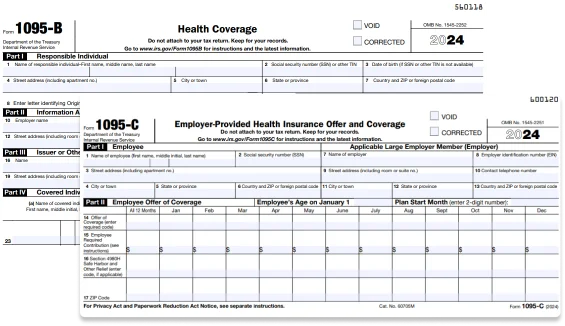Know about ICHRA and the new codes added for 2024 tax year
Updated on November 13, 2024 - 03:00 pm by, TaxBandits
The IRS established the ICHRA with a new set of rules on October 23, 2018. The IRS finalized it on June 13, 2019. And, it was made available for the users on January 01, 2020. ICHRA is a new health benefit and can be provided by businesses of any size. You may now have many questions related to ICHRA.
To learn more about ICHRA, continue to read on!
The following are the topics covered under this article:
1. What is ICHRA?
ICHRA is a new health benefit that can be offered by an employer to their employees. ICHRA is a short form of Individual Coverage Health Reimbursement Arrangements. This is a new way of providing health plans to employees. ICHRA is an employer-funded health benefit that can be used to reimburse the healthcare costs spent by employees. To be precise, ICHRA is an upgraded version of QSEHRA, one of the HRA types.
The two significant aspects of the ICHRA are as follows:
- Employees are allowed to buy the health plan they want.
- Employers will set an allowance of tax-free amount for reimbursing the health plan cost and related expenses.
After purchasing the plan, employees need to submit claims for reimbursement. Based on the allowance amount set by the employer, the premium and other costs will be reimbursed. The amount on ICHRA by both employer and employee is tax-free.
2. ICHRA vs Other HRAs
ICHRA is a better health benefit when compared to other traditional HRAs. We have listed out the advantages of ICHRA over other HRAs.
- ICHRA is available for businesses of all sizes.
- As an employer, you don’t have to spend an additional cost as you can define the budget or allowance allocated to the employees initially.
- Unlike other HRAs, ICHRA allows employees to choose their health plans.
- There is no need for the employer to provide its employees with the same allowance. Employers can categorize the employees and provide them with different reimbursement allowances.
- It is not mandatory to provide ICHRA for all employees. Employers can offer a few employees with ICHRA and other employees with group plans.
3. Which employee is eligible for ICHRA?
According to ICHRA, employees can choose the employees eligible for ICHRA. They can classify employees from the following categories and can set tax-free allowances for each category.
Employees eligible for ICHRA are listed below:
- Full-time employees
- Part-time employees
- Salaried employees
- Employees in the waiting period
- Hourly employees
- Seasonal employees
- Employees working abroad or NRI employees
- Temporary employees in staffing firms
- Combination of one or more of the above
Know more information about ACA Reporting Requirements
4. How is ICHRA affordability calculated?
ICHRA affordability differs for each employee based on three factors below:
- Lowest Cost Silver Plan
- ACA Affordability Percentage
- Employee Household Income
ACA affordability of the employee should satisfy the below condition:

Affordable ICHRA Calculation > Lowest Cost Silver Plan - (ACA affordability percentage * Employee
Household income)
The Lowest Cost Silver Plan is a reference plan, and the IRS has given the safe harbors below to determine it.
- Location
- Age-based brands
- Prior year
To calculate the Employee Household Income, the IRS has proposed the following safe harbors.
- W-2 wages
- Ray of pay
- Federal Poverty Line
The ACA affordability percentage should not exceed 8.39% of the employee’s household income for the tax year 2024.
Based on the calculations, if the ICHRA is affordable for the employee, he/she is not eligible for Premium
Tax Credits (PTC).
If the ICHRA is not affordable, he/she can choose ICHRA or get the Premium Tax Credits (PTC).
5. What are the ICHRA Rules and Regulations?
Here is the list of rules and regulations proposed for ICHRA:
- ICHRA can be offered by all employers regardless of their business size, i.e., employee count.
- Employees under different categories can be offered different reimbursement allowances and benefits.
- ICHRA can be offered during any month of the year.
- For ICHRA, there is no restriction on monthly reimbursement amounts.
- When ICHRA is not affordable, employees can choose ICHRA or get Premium Tax Credits.
- If ICHRA is affordable, employees are not eligible for receiving Premium Tax Credits.
- Employees should be given a chance to opt-out of receiving the monthly reimbursements once a year.
- ICHRA will not cover the reimbursement of medical care costs, such as Copay, deductible, short-term, limited-duration insurance, and dental or vision-related costs.
6. What is ICHRA Reporting?
Employers who offer ICHRA for their employees should complete 1095-B and 1095-C. For the tax year 2024, no new changes are incorporated into ACA forms.
Prior Year Changes to Form 1095-C
New 1095-C codes (1T - 1U) are to be entered in line 14 based on how the affordability of ICHRA is calculated.
-
1T:
The Individual coverage HRA offered to the employee and spouse (no dependents) and affordability was determined using the employee's primary residence location ZIP code.
-
1U:
The Individual coverage HRA offered to the employee and spouse (no dependents) and affordability was determined using the employee's primary employment site ZIP code affordability safe harbor.
Click here to know more about 1095-C codes.
If you want to e-file your ACA forms, TaxBandits is here to help you! Create a FREE account at TaxBandits to e-file your 1095-B, 1095-C, 1094-B, and 1094-C.
Get started with TaxBandits today!



